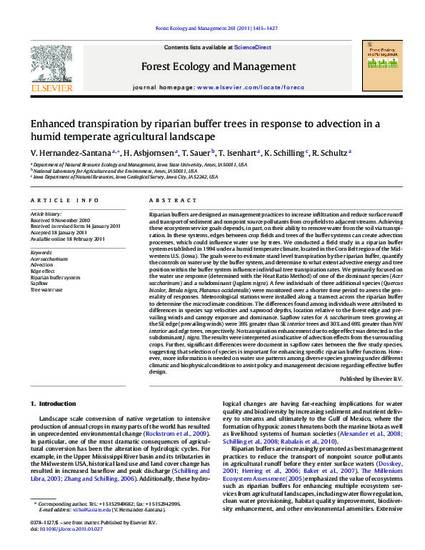
Riparian buffers are designed as management practices to increase infiltration and reduce surface runoff and transport of sediment and nonpoint source pollutants from crop fields to adjacent streams. Achieving these ecosystem service goals depends, in part, on their ability to remove water from the soil via transpiration. In these systems, edges between crop fields and trees of the buffer systems can create advection processes, which could influence water use by trees. We conducted a field study in a riparian buffer system established in 1994 under a humid temperate climate, located in the Corn Belt region of the Midwestern U.S. (Iowa). The goals were to estimate stand level transpiration by the riparian buffer, quantify the controls on water use by the buffer system, and determine to what extent advective energy and tree position within the buffer system influence individual tree transpiration rates. We primarily focused on the water use response (determined with the Heat Ratio Method) of one of the dominant species (Acer saccharinum) and a subdominant (Juglans nigra). A few individuals of three additional species (Quercus bicolor, Betula nigra, Platanus occidentalis) were monitored over a shorter time period to assess the generality of responses. Meteorological stations were installed along a transect across the riparian buffer to determine the microclimate conditions. The differences found among individuals were attributed to differences in species sap velocities and sapwood depths, location relative to the forest edge and prevailing winds and canopy exposure and dominance. Sapflow rates for A. saccharinumtrees growing at the SE edge (prevailing winds) were 39% greater than SE interior trees and 30% and 69% greater than NW interior and edge trees, respectively. No transpiration enhancement due to edge effect was detected in the subdominant J. nigra. The results were interpreted as indicative of advection effects from the surrounding crops. Further, significant differences were document in sapflow rates between the five study species, suggesting that selection of species is important for enhancing specific riparian buffer functions. However, more information is needed on water use patterns among diverse species growing under different climatic and biophysical conditions to assist policy and management decisions regarding effective buffer design.
Available at: http://works.bepress.com/richard_schultz/12/

This article is from Forest Ecology and Management 261 (2011): 1415, doi:10.1016/j.foreco.2011.01.027.